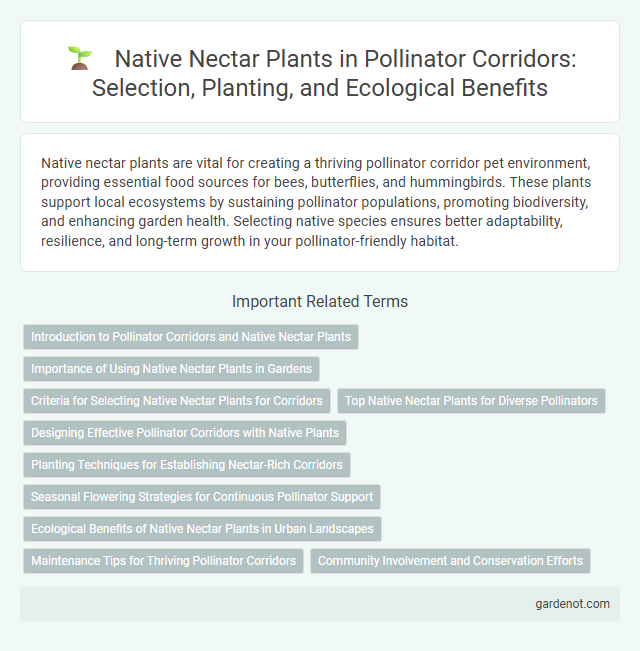Native nectar plants are vital for creating a thriving pollinator corridor pet environment, providing essential food sources for bees, butterflies, and hummingbirds. These plants support local ecosystems by sustaining pollinator populations, promoting biodiversity, and enhancing garden health. Selecting native species ensures better adaptability, resilience, and long-term growth in your pollinator-friendly habitat.
Introduction to Pollinator Corridors and Native Nectar Plants
Native nectar plants play a crucial role in pollinator corridors by providing essential food sources for bees, butterflies, and other pollinating insects. These plants, adapted to local ecosystems, support biodiversity and enhance the sustainability of pollinator populations. Establishing pollinator corridors with native nectar species increases habitat connectivity and promotes healthy pollination cycles vital for agricultural productivity and ecological balance.
Importance of Using Native Nectar Plants in Gardens
Using native nectar plants in gardens supports local pollinator species by providing adapted, nutrient-rich food sources critical for their survival. These plants enhance biodiversity, attract a variety of bees, butterflies, and hummingbirds, and promote ecological balance by sustaining native pollination networks. Incorporating native flora also reduces the need for chemical inputs and supports habitat restoration within pollinator corridors.
Criteria for Selecting Native Nectar Plants for Corridors
Native nectar plants for pollinator corridors should be selected based on bloom period to ensure continuous floral resources throughout the growing season. Plant species must provide high nectar quality and quantity, supporting diverse pollinator species such as bees, butterflies, and hummingbirds. Soil type adaptability and regional climate compatibility ensure sustainable growth and habitat restoration within the corridor.
Top Native Nectar Plants for Diverse Pollinators
Top native nectar plants such as Asclepias tuberosa (butterfly weed), Monarda fistulosa (wild bergamot), and Solidago spp. (goldenrod) provide vital floral resources for diverse pollinators including bees, butterflies, and hummingbirds. These species offer high nectar volumes with concentrated sugars, attracting a wide range of pollinating insects and supporting pollinator biodiversity within corridor habitats. Incorporating native nectar plants enhances ecosystem resilience by sustaining pollinator populations critical for plant reproduction and food web stability.
Designing Effective Pollinator Corridors with Native Plants
In designing effective pollinator corridors, selecting native nectar plants such as milkweed (Asclepias spp.), purple coneflower (Echinacea purpurea), and goldenrod (Solidago spp.) enhances habitat connectivity and supports diverse pollinator species. These native plants provide essential foraging resources throughout the growing season, ensuring continuous nectar availability and promoting pollinator health. Incorporating native flora helps maintain ecological balance by supporting local pollinator populations and improving biodiversity in fragmented landscapes.
Planting Techniques for Establishing Nectar-Rich Corridors
Selecting native nectar plants with deep roots enhances soil stability while providing continuous bloom cycles that attract diverse pollinators. Planting techniques such as staggered sowing and layered planting optimize spatial resources, ensuring year-round nectar availability and habitat connectivity. Incorporating native grasses and flowering perennials in clustered patterns supports pollinator movement and increases the ecological resilience of nectar-rich corridors.
Seasonal Flowering Strategies for Continuous Pollinator Support
Native nectar plants exhibit diverse seasonal flowering strategies that ensure continuous food sources for pollinators throughout the year, enhancing the stability of pollinator corridors. Early-blooming species like red maple and witch hazel provide vital resources in spring, while summer-flowering milkweed and goldenrod sustain pollinators during peak activity. Fall-blooming asters and late-season joe-pye weed extend nectar availability, supporting pollinator populations as they prepare for overwintering or migration.
Ecological Benefits of Native Nectar Plants in Urban Landscapes
Native nectar plants in urban landscapes enhance biodiversity by providing essential food sources for local pollinators such as bees, butterflies, and hummingbirds. These plants support ecosystem services including pollination, which boosts urban agriculture and green space vitality. Their deep root systems improve soil health and water retention, mitigating urban runoff and contributing to climate resilience.
Maintenance Tips for Thriving Pollinator Corridors
Native nectar plants play a crucial role in supporting thriving pollinator corridors by providing essential food sources for bees, butterflies, and hummingbirds. Regular pruning, mulching, and seasonal watering maintain plant health and encourage continuous blooming, which sustains pollinator activity throughout the year. Monitoring for invasive species and implementing integrated pest management techniques protect native plants, ensuring a resilient habitat for diverse pollinator populations.
Community Involvement and Conservation Efforts
Native nectar plants play a crucial role in supporting pollinator corridors by providing essential food resources for bees, butterflies, and other pollinators throughout their lifecycle. Community involvement in planting and maintaining these native species enhances biodiversity and strengthens local ecosystems, fostering habitat connectivity. Conservation efforts often include educational programs and volunteer initiatives that engage local residents to restore native plant populations and promote sustainable land management practices.
Native nectar plant Infographic

 gardenot.com
gardenot.com